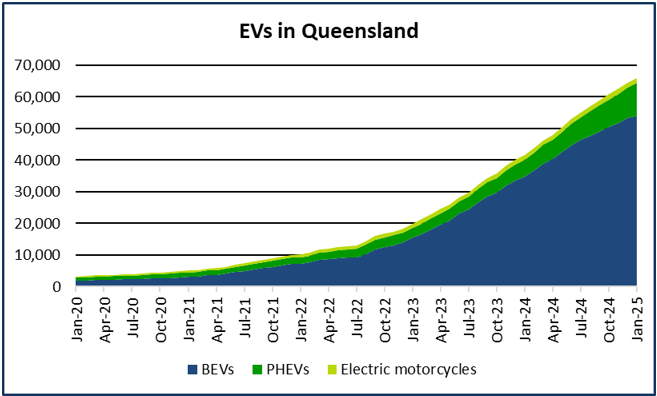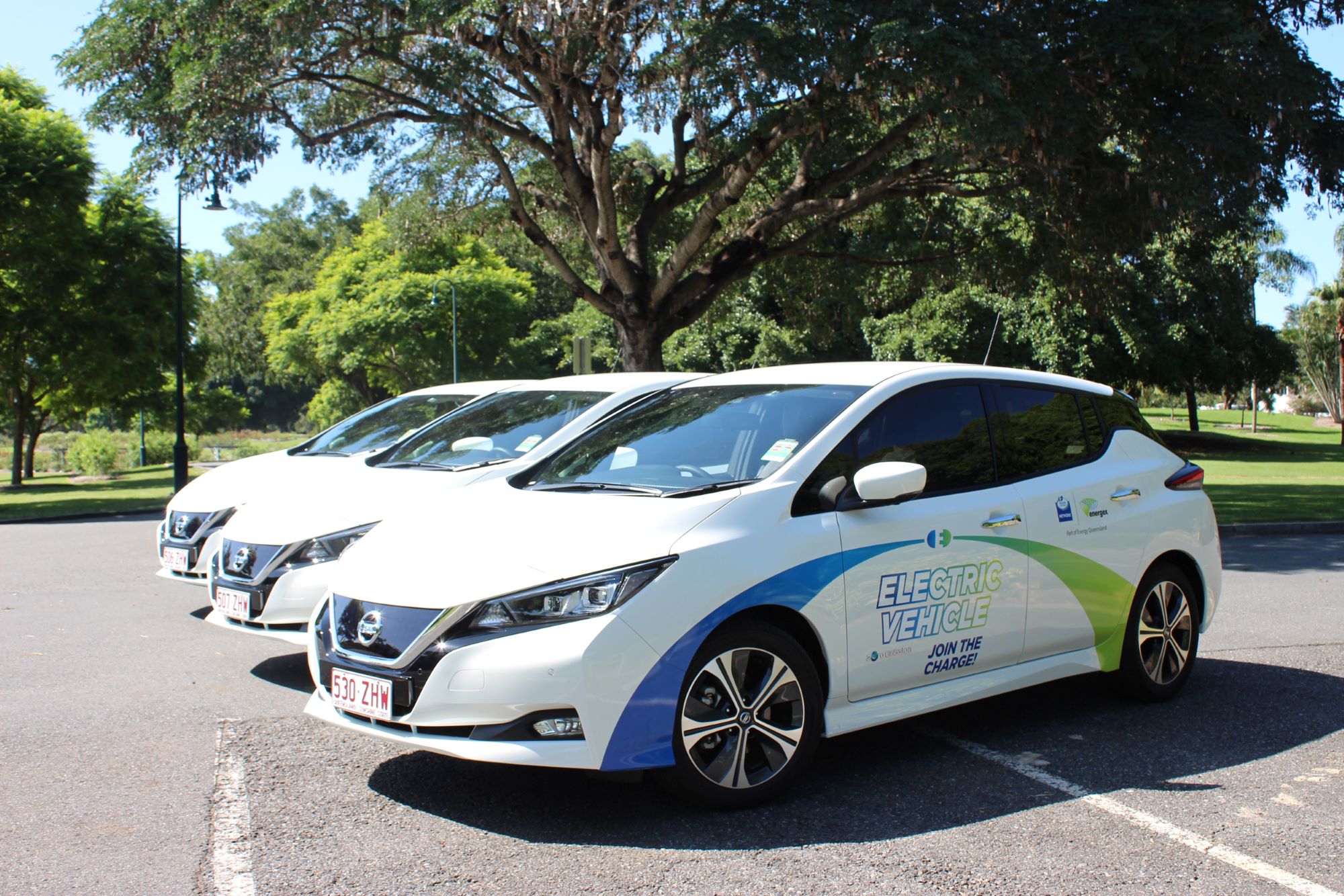EV insights
Read up on key insights from our Electric Vehicle (EV) research program and keep informed on other relevant insights including volume of EV growth in Queensland.
If you have any questions about the information on this page, please contact us at evsmartcharge@energyq.com.au
EV SmartCharge Queensland Program
Just as we evolved to support an abundance of air conditioning and rooftop solar, we will need to cater for the electrification of transport.
Balancing demand and supply has always been the key to delivering secure, affordable, sustainable and safe energy solutions.
That’s why, back in May 2020, we embarked on an Electric Vehicle (EV) research program focussed on residential charging, to get on the front foot. We gathered data to help us understand the needs of our customers and the potential impact of their EV charging behaviours on the electricity network.
The results of the program, which analysed driving and charging profiles of Queensland EV owners, is helping us drive decisions that will benefit EV customers and the electricity network that supports them.
Read the results in our EV SmartCharge Queensland Insights Report (PDF 19.4 mb) and view our short video below.
The report will inform the development of new tariffs, dynamic customer connections and demand management opportunities. As an industry we are facing a new wave of opportunities and challenges from EVs, so it is critical to have the data to get in early and come up with real solutions that are good for you and good for the network.
Some of the insights in our report explore:
- The influence of electricity tariffs on EV charging behaviour
- Different charging profiles dependent on solar, non-solar and or battery energy storage system ownership
- Network implications of EV charging
- Weekday and weekend charging
- Charging behaviour at home versus other locations
- Length of charge – top up versus long charge
- Distances travelled.
Summary of key learnings
Skip to descriptionWe did find that the average commute for customers used about between 6-10 kilowatt hours per day. So that’s a relatively easy opportunity for charging, whether it’s a slow charge off a simple plug or whether you want to have a special fast charger in your home.
So plenty of opportunity for customers to charge their EVs quite simply on a daily basis.
We found that far more people charged away from home than other studies would have actually suggested, so this is where a Queensland perspective has been quite interesting.
Other studies have shown that on average about 80% of charging happens at home. We found it was nearer more the mid-60s, which for us gives us an understanding that people are more happy to travel longer distances and charge away from home.
The other thing that we did find was that compared to ICE vehicles – internal combustion engine or traditional engine vehicles – people were travelling about 20% further in their EVs than a normal petrol/diesel car.
Certainly, you want to look at the sort of trips that you do, but with the vehicles these days, most trips are not a problem at all with fast-charging – 300 or 400km trips are no problem at all. Now with the Tesla, with the much longer range, we basically never have range anxiety.
The penetration of solar in Queensland, even compared to other states in Australia, is high and so that’s going to provide a difference that we wanted to understand – how people use their renewables and solar generation at home to impact their EV charging behaviour.
Also the fact that we have a highly-urbanised society as well as our regional and rural customers, and we wanted to understand necessarily how EV charging would be impacted by where people actually live.
I think the key thing is you know people are looking at you know what sort of charging behaviours are financially beneficial in terms of charging when the rates are low.
As we have now understood a lot more about how customers like to charge their EVs and indeed what the opportunities around tariffs and solar generation mean for customers, we can work into that options that can provide customers future-proof solutions for charging that will be suitable for them and for the network for many, many years to come.
Summary of key learnings
Watch this video to find out what we learnt about EV owner charging behaviours in Queensland.
Customer experience journey mapping research
We completed research jointly with Energex to understand the customer experience from consideration of buying an EV, through to how customers use and manage their EVs, with a focus on how they charge their EVs.
Research highlights
- Price was the barrier to purchasing an EV
- Charging EVs became part of a total home energy management routine for those who have a home battery and solar
- The preference was to avoid using the grid and leverage solar power charge EVs (and home batteries)
- A common charging behaviour was to ‘top-up’ the EV battery to meet travel requirements for the next day, with an allowance of additional kilometres as a ‘safety buffer’.
Read the full research report in EV Customer Experience Journey Mapping (PDF 775.2 kb).
Queensland Household Energy Survey
This unique survey has over 4,200 participants each year, of which a small but increasing proportion have an EV. We ask those EV owners:
- About their home charging arrangement
- Their behaviours and influences
- Where their EV is parked during the day
- What challenges they had when buying their EV, and more.
Read the results from the EV questions. From that same page, you can access other insights from the survey, about solar PV, battery storage and more.
 EV numbers
EV numbers
At the end of January 2025, Queensland had registrations for:
- 54,119 BEVs, including 284 light commercial vehicles, 160 electric buses and 32 electric trucks,
- 10,258 PHEVs, and
- 1,690 electric motorcycles,
creating a total of:
- 64,377 EVs excluding motorcycles, and
- 66,067 including motorcycles.
Source: Analysis of data of battery EVs and plug-in hybrid EVs provided monthly to us by the Queensland Department of Transport and Main Roads under a Memorandum of Understanding.
 EV market shares
EV market shares
At the end of January 2025, EVs reached market shares in Queensland of:
- 1.93% of cars,
- 0.70% of motorcycles,
- 0.67% of buses, and
- 0.03% of trucks.
Source: Analysis of data of battery EVs, plug-in hybrid EVs and all vehicles provided monthly to Energex and Ergon Energy Network by the Queensland Department of Transport and Main Roads under a Memorandum of Understanding.
Of all EVs (excluding motorcycles) in Queensland, 89.7% are registered in South East Queensland, and 10.3% in regional Queensland. Approximately 69% of Queenslanders live in South East Queensland.
Except as permitted by the copyright law, you may not reproduce or communicate any of the content on this web page, including files downloadable from this web page, without the permission of the copyright owner.

